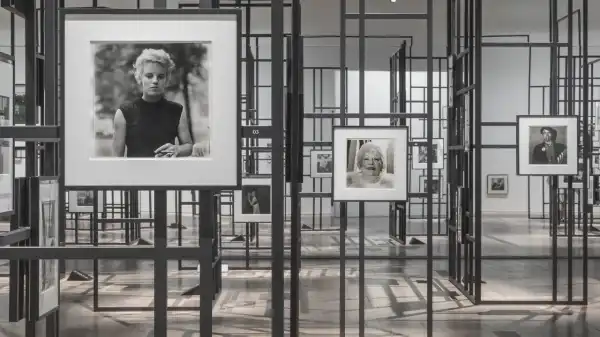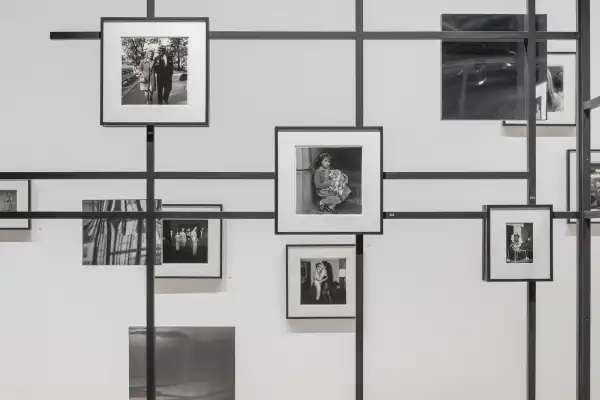
Save this storySave this storySave this storySave this story
Nude but for white lingerie, Diane Arbus looks at herself in a full-length mirror tilted to the right. One arm hangs over her rounded belly; the other holds the tripod leg of her large-format Deardorff camera. Her black shawl resembles a nun’s cowl; the camera lens is at chest level. Taken long before Arbus discovered her lumpen nudists and “female impersonators,” her withered matrons and strange triplets, Self-Portrait, Pregnant, New York 1945—the earliest work in the recently opened Constellation at the Park Avenue Armory—was made for her husband and early partner, Allan Arbus, who was then abroad. It is as much a self-portrait of the camera as it is a self-portrait of the woman cameraman, even a self-portrait as a camera – or perhaps as “a kind of magic mirror reflecting back what everyone wants to believe, because I can’t believe they believe it,” as Arbus later described herself. “Like Atlas holding a bubble and moaning.”
“Constellation,” the largest exhibition of Arbus’s work in New York, is replete with such reflections. First shown in 2023 at the LUMA Foundation in Arles, France, the 454 images hang on large metal frames that rise from the high ceilings of the Arsenale. Mirrors are mounted on the back of each frame; in some of them, you can see your reflection, as if the camera were pointing at you. A huge mirror also spans one wall of the exhibition. Leaving aside the unhelpful allusion to a hall of mirrors—Arbus loved funhouses and funfairs, but she didn’t build them—it’s a gesture that never really goes beyond a gimmick: Once you see your reflection next to Eddie Carmel, the Jewish giant, you’ve got the point.
The show is blissfully, almost eerily, undirected. Curator Mathieu Humery rejects any chronological or thematic organization, allowing the viewer to wander, as he imagined Arbus did through New York. (He cited the subway map as an inspiration.) The photographs are numbered, but in no clear order, and to learn the titles you have to squint at small signs on the floor or consult a road-map-sized checklist. You almost never know why one image is placed next to another: why is Tokyo Rose hanging beneath Mia Farrow, just up the wall from a group of Santas in Santa Claus School? The effect is disorienting—like a yearbook laid out by Mondrian—but that’s precisely why it’s revealing. “Constellation” frees Arbus’s images from their backstories, asking you to look with formalist intensity at the photographs themselves alone.
“I would like to photograph everyone,” Arbus once wrote, and they are all here. Famous people are intertwined with the unknown; strange bedfellows abound. This remarkably complete collection consists of proofs created by Neil Selkirk, who was appointed sole printer of her work after Arbus’s suicide in 1971. (Maja Hoffmann, the Swiss billionaire who runs LUMA, purchased the prints directly from Selkirk.) In a brief wall text—the only introduction to the exhibition, aside from a note from Humery, a timeline, and dramatic projections of just the eyes from Arbus’s portraits—Selkirk describes the “extraordinarily painstaking” work it took to understand how Arbus did Arbus.

Sourse: newyorker.com